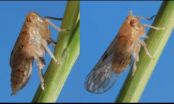(Press-News.org) DURHAM, N.C. -- Each year, rice in Asia faces a big threat from a sesame seed-sized insect called the brown planthopper. Now, a study reveals the molecular switch that enables some planthoppers to develop short wings and others long -- a major factor in their ability to invade new rice fields.
The findings will appear Mar. 18 in the journal Nature.
Lodged in the stalks of rice plants, planthoppers use their sucking mouthparts to siphon sap. Eventually the plants turn yellow and dry up, a condition called "hopper burn."
Each year, planthopper outbreaks destroy hundreds of thousands of acres of rice, the staple crop for roughly half the world's population.
The insects have a developmental strategy that makes them particularly effective pests. When conditions in a rice field are good, young planthoppers develop into adults with stubby wings that barely reach their middles.
Short-winged adults can't fly but they're prolific breeders. A single short-winged female can lay more than 700 eggs in her lifetime.
"The short-winged ones have great big fat abdomens. They're basically designed to stay put and reproduce," said biologist Fred Nijhout of Duke University, who co-authored the study with colleagues at Zhejiang University in China.
But in the fall as days get shorter and temperatures begin to drop -- signs that the rice plants they're munching on will soon disappear -- more planthopper nymphs develop into slender adults with long wings. Long-winged planthoppers lay fewer eggs but are built for travel, eventually flying away to invade new rice fields.
Until now, scientists did not know exactly how the shorter days and cooler temperatures triggered the shift between short and long wings, or which hormones were involved.
To find out, the researchers used a technique called RNA interference (RNAi) to silence the genes for two different insulin receptors -- regions on the cell membrane that bind to the hormone insulin -- and measured the effects on the animals' wings.
"Previously it had been assumed that all insects only had a single insulin receptor gene. We discovered that brown planthoppers have two," Nijhout said.
When the researchers silenced the first insulin receptor, short-winged adults emerged. Silencing the second receptor produced adults with long wings.
Further study revealed that long wings are the default design. But when planthoppers secrete a particular type of insulin in response to changing temperatures or day length, the second insulin receptor deactivates the first receptor in the developing wings, leading to short-winged adults.
"The second insulin receptor acts by interfering with the first one, therefore shutting down the signal," Nijhout said.
It's too early to say whether the findings could lead to techniques to treat planthopper populations so they are unable to invade new rice fields, Nijhout says.
But the researchers have found similar mechanisms in other planthopper species, and are now trying to find out if insulin plays a similar role in other insect pests with flying and flightless forms, such as aphids.
INFORMATION:
This research was supported by the National Basic Research Program of China (973 Program, no. 2010CB126205) and by the National Science Foundation of China (no. 31201509 and no. 31471765).
CITATION: "Two insulin receptors determine alternative wing morphs in planthoppers," Xu, H-J et al. Nature, March 18, 2015. DOI: 10.1038/nature14286
Researchers have linked antibiotic resistance with poor governance and corruption around the world.
Lead researcher Professor Peter Collignon from The Australian National University (ANU) School of Medicine said the increase in antibiotic-resistant infections was one of the greatest threats facing modern medicine.
In the United States alone, around 23,000 deaths and two million illnesses each year have been attributed to antibiotic-resistant bacteria.
"We found poor governance and higher levels of corruption are associated with higher levels of antibiotic resistance," ...
COLUMBUS, Ohio - Cardiovascular researchers at The Ohio State University Wexner Medical Center have shown that a protein known as MG53 is not only present in kidney cells, but necessary for the organ to repair itself after acute injury. Results from this animal model study are published in the journal Science Translational Medicine.
Previous work by Jianjie Ma, a professor and researcher in Ohio State's Department of Surgery and the Dorothy M. Davis Heart & Lung Research Institute, identified and proved that MG53 repairs heart, lung and skeletal muscle cells as well.
"MG53 ...
Although bike-sharing systems have attracted considerable attention, they are falling short of their potential to transform urban transportation.
A new study by University of Chicago Booth School of Business Assistant Professor Elena Belavina, INSEAD Professor of Sustainable Development Karan Girotra and INSEAD Ph.D. candidate Ashish Kabra found that it is possible for cities to increase ridership without spending more money on bikes or docking points -- simply by redesigning the network.
The researchers spent four months in Paris observing the Velib' bike-share system ...
While doctors almost always agree on a pathological diagnosis of invasive breast cancer, there is room for improvement when diagnosing atypia (or atypical ductal hyperplasia-ADH) and DCIS (ductal carcinoma in-situ), Anna Tosteson, ScD and Tracy Onega, PhD from Dartmouth-Hitchcock's Norris Cotton Cancer Center have found. The Dartmouth investigators, and national collaborators, published the study, "Diagnostic Concordance Among Pathologists Interpreting Breast Biopsy Specimens," today in JAMA.
"About 1.6 million breast biopsies are done every year in the U.S., yet in nearly ...
CORVALLIS, Ore. - A new study from Oregon State University suggests there is a relationship between low levels of vitamin D and depression in otherwise healthy young women.
OSU researchers found that young women with lower levels of vitamin D were more likely to have clinically significant depressive symptoms over the course of a five-week study, lead author David Kerr said. The results were consistent even when researchers took into account other possible explanations, such as time of year, exercise and time spent outside.
"Depression has multiple, powerful causes ...
Interviewing women at a breast-imaging center in an urban safety net institution before and after they used a "mHealth" mobile health app on a tablet, Elissa Ozanne, PhD from Dartmouth's Norris Cotton Cancer Center and colleagues concluded that older, diverse, and low income women found it easy to use and acceptable. Published in the Journal of Health Disparities Research Practices, the paper with these findings is "Can mHealth Improve Risk Assessment in Underserved Populations? Acceptability of a Breast Health Questionnaire App in Ethnically Diverse, Older, Low-Income ...
Biochemists at the Ruhr-Universität Bochum have gained new insights into the generation and maintenance of circadian rhythms. They demonstrated that the Ras protein is important for setting the phase of such a circadian clock, as its activity determines the period length of the rhythm. Ras is also contributing to induce phase-shifts in circadian rhythms in response to external time cues such as light. The team headed by Prof Dr Rolf Heumann published their results in the magazine "Molecular Neurobiology".
Ras activity varies throughout the day
The circadian clock ...
Absence, it seems, really does make the heart grow fonder.
That's according to research conducted by UC Santa Barbara anthropologists, who found that levels of the "love" hormone oxytocin increases among Tsimane men when they come home to their families after a day of hunting. The researchers also found that the increase in oxytocin was greater for those men who were absent longer, and it positively correlated with changes in testosterone. Their findings are published in the Royal Society journal Biology Letters.
The Tsimane are an indigenous population of forager-farmers ...
For many, Facebook connects friends, family, and others with common interests. Despite the popularity of social networking sites like Facebook, scientists are only beginning to learn how they affect human interaction.
In a recent study published by the journal Social Science & Medicine, Dartmouth researchers examined nearly 9,000 Facebook conversations to better understand how people seek and receive support on social networking sites.
"Among the many Facebook conversations that were mostly casual, we noticed more serious exchanges among people who mentioned a major ...
As one of the strongest cyclones every recorded in the South Pacific Ocean, Cyclone Pam devastated the island archipelago of Vanuatu. The Global Precipitation Measurement or GPM core observatory provided data on rain rates throughout the storm. At the end of Pam's life on March 17, NASA's RapidScat provided a look at the winds of the waning storm.
As the cyclone bore down on Vanuatu's central islands on the afternoon (local time) of March 13, 2015, Pam's maximum sustained winds were estimated to have increased to 270 kph (~167 mph) by the U.S. Joint Typhoon Warning Center ...



